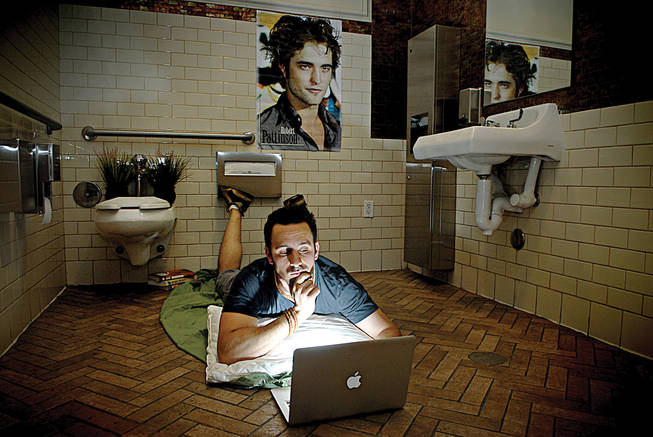
Jacob Kepler
Rick Lax likes Town Square so much he decided to move in. Unfortunately, the “lifestyle center” isn’t zoned for writers sleeping in the handicapped bathrooms.
Thursday, Sept. 17, 2009 | midnight
We don’t have utopia, but we do have Town Square. And in a lot of ways, Town Square is better. The grass is greener (because it’s Astroturf(1), the music is clearer (because the speakers are hidden in the planters), and the bars stay open later (does Utopia even have bars?). But like Sir Thomas More’s fictitious island society, Town Square is too good to be true. I found that out the hard way … by moving in.
On a recent Wednesday I hopped aboard Mike Wethington’s golf cart for a grand tour of Town Square, the 1.5 million-square-foot “lifestyle center” located just south of Mandalay Bay. Mike, Town Square’s general manager, drove me past the botanical garden, around the footbridge and stone waterfall and throughout Town Square’s 22 buildings, whose architectures shows Parisian, San Franciscan, Bostonian and Barcelonan influences.
“We’ve got over 70 different façade types,” Mike told me. “Our intent was to make Town Square look like a city that developed over the years.”
Quick example: The Lucky Brand Jeans store has a mansard roof(2), the Express store has a mission-style roof(3), and the Tommy Bahama store has, appropriately, a Bahamian/colonial/plantation/antebellum-style roof(4). Only Sephora’s roof, which displays a “2007” historical marker, betrays Town Square’s through-the-years architectural motif. But aside from the girls who work at the sunglasses kiosk below, I doubt anybody’s given much thought to it, let alone noticed it.
For lunch Mike and I met up with Town Square Marketing Director Mary Kathryn at Anthony’s Coal Fired Pizza. Anthony’s, a Floridian import, serves “pizza well done”—and that’s not just a slogan; Anthony’s keeps its ovens at 800 degrees. Over chicken wings (also coal-oven roasted), eggplant Marino and vegetable pizza, I asked Mike and Mary if they had read Review-Journal columnist Geoff Schumacher’s recent piece on Town Square.
In case you missed it, Schumacher called Town Square “the new Downtown,”(5) and the comment sparked more controversy than a Mel Gibson movie. Apparently some Las Vegans think Downtown Las Vegas (the one with the low-res TV on the ceiling and the football-shaped souvenir glasses) is still Downtown Las Vegas. Go figure.
Mike and Mary said they were aware of Schumacher’s article and pleased with it.
“Town Square was designed to be like a real downtown,” Mike told me, “a place where people would come to meet. Schumacher’s comment is a compliment to our intent and design.”
“We had 30,000 people visit us on Halloween last year,” Mary added, “and 15,000 for Santa’s arrival. We’re not just putting on events; we’re starting family traditions. And we want to draw families, year after year.”
“With all those families coming through,” I said, “security must be a big issue here.”
“The biggest crime people commit at Town Square …” Mary replied, “… is shopping too much! A lot of wives get in a lot of trouble here.”
I got the sense she’d gotten a lot of mileage out of that line.
“The most typical crimes are shoplifting and vandalism,” Mike said, on a more serious note. “Maybe somebody goes at a mirror in the restroom, scrapes it. We’ve had some vehicle break-ins, but that’s it. We haven’t had any major incidences, and that’s because we have a strong, around-the-clock security presence. We have to; our bars close at 4 [a.m.], we get deliveries in at 5 and 6, and we get office tenants arriving at 7 and 8. Plus, we’ve always got families and children around.”
Mike’s comment brought us to the Town Square Children’s Park (both literally and figuratively; we started walking there after our meal). Mike and Mary talk about the park the way most parents talk about their children. Let’s just say I wouldn’t have been surprised if they’d pulled out photos of the park from their wallets.
When we arrived, I saw what all the fuss was about. Town Square Children’s Park has a 35-spritzer pop-jet fountain, a 40-foot-tall tree house, a hand-painted puppet theater and a hedge maze adorned with an animatronic elephant, monkey, dolphin and flamingo.
But the hedge maze, I came to realize, isn’t actually a “maze” (a tour puzzle in which some paths take you to the goal and others lead to dead ends); it’s a single, jagged, looping path bisected by a connecting path. In other words, it has no dead ends. But I suppose that just provides further evidence in support of Mike’s spiel about Town Square being safe for children.
As I exited the “maze”—it wasn’t hard—I felt a thought emerging. I felt it on the tip of my brain. And little by little, my mind started putting the pieces together: safe for children … no serious crime … bountiful employment opportunities … good nightlife … and then it hit me: Town Square is the perfect place to live.
I began imagining a new life for myself—a life filled with luxury, beauty, indulgence and relaxation—a life free from crime, boredom, poverty, long drives and real dirt. Then I enlisted Mike and Mary’s help:
“Describe the perfect day in Town Square,” I said.
Mary didn’t hesitate for a second: “You could start your morning at The Coffee Bean. Get a latte, maybe a muffin, pick up a newspaper and read it outside. Then you could stroll down the street and do some window-shopping. Then lunch at Brio Tuscan Grille—maybe enjoy a glass of wine. In the afternoon, you could catch a movie at Rave or relax at the Eleven Spa.”
Mary paused to think, and Mike continued right where she left off: “You could grab dinner at Texas de Brazil Churrascaria. Then listen to some live music at Blue Martini, maybe ride the mechanical bull at Cadillac Ranch, maybe sample the 160 different beers at Yard House, maybe catch the game at Bar Louie. And at that point, if you’re still not tired, you could grab late-night breakfast at Johnny McGuire’s.”
That’s when I decided: I’m going to move into Town Square.
Here’s the e-mail I sent Susan Holland, Town Square’s leasing manager: “Hi Susan, I’m in love with Town Square, and I’m thinking about renting some property there. Tell me, are all your renters as happy as they seem to be? –Rick”
Holland’s reply: “Thank you for the compliments, and we strive for each customer to have an opinion like yours. In terms of leasing, are you interested in retail or office? Thank you.”
My reply: “Of course; compliments are well deserved in this case! But if I’m going to become part of the Town Square family; I’d like to be considered more than a ‘customer.’ Seems a little formal—don’t you think? I’d like to think of myself as a ‘resident.’ I’m interested in a one-bedroom apartment. How much would that run me?”
Holland’s reply: “Our upper levels are all designated as office space. There are no current plans for any type of extended living.”
No extended living? Huh?
Surely Holland was mistaken. Surely Turnberry Associates didn’t construct this modern-day Shangri-La only to forbid people from moving in. That’d be like grilling a flank steak in front of an emaciated puppy and then tossing it in the trash—the puppy, that is. Perhaps Holland was playing some kind of practical joke?
Nope; here’s what senior leasing director George Radu had to say about Holland’s e-mail: “She is correct: We do not have any residential at the Town Square Lifestyle Center.”
Ah. Therein lies the discrepancy: “Lifestyle Center” is the noun phrase; “Town Square” is merely the (incredibly deceptive) proper noun. The thing that makes it so deceptive is that the center area of Town Square not only looks like a real town square—a publicly owned area used for public gathering—but it functions as one, too. Of course, real town squares (e.g., Trafalgar Square, Tiananmen Square, Times Square) are owned by governments; the Town Square center area (like Town Square Major) is owned by Turnberry Associates, a 50-year-old, $7 billion real-estate development and property management corporation.
And just as the Town Square center area isn’t a real public town square, Town Square Major isn’t a town. It’s a shopping mall(6,7)—sorry, “lifestyle center.” I got in touch with UNLV Professor of Sociology Michael Borer to discuss the phenomenon of private space functioning as public(8). Here’s what he had to say:
“Consumption sites—especially outdoor malls like Town Square—are neither totally private nor totally public. They perform the same functions of traditional public spaces, but they’re ultimately controlled by property owners, who can regulate the spaces through laws and design elements. The amount of regulation—security and surveillance—and how that amount is perceived will determine the inclusivity or exclusivity of that space.”
Town Square must have found the perfect amount of security and surveillance because the place seems safe and free, yet everybody there is well-to-do and quick-to-spend.
“A traditional public space,” Borer went on, “is one where all are free to enter, interact and leave at their will. Shopping malls, or ‘lifestyle centers,’ can never meet such lofty ideals. But if regulation is kept low, they can provide spaces for people to gather, to interact and to share not only goods and products, but ideas and beliefs as well.”
It’s not all bad, is professor Borer’s point, but the “lifestyle center” isn’t all-new either: “Renaming ‘shopping malls’ ‘lifestyle centers’ supports the idea that our identities are dependent upon the things we buy. And when it comes to ‘lifestyle centers,’ nothing is new; everything is just rebranded to meet the ‘needs’ of a ‘diverse’ consumer base. Even ‘the mall’ itself has been rebranded, and identities become simply things that are bought rather than built.”
The rebranding isn’t accidental. Turnberry Associates designed Town Square to resemble a real town for one purpose and one purpose only: to increase sales.(9)
Well, I thought, if Town Square is going to act like a town, I’m going to treat it like one. Residential units or not, I’m moving in.
On Friday I vacated my cozy tri-level townhouse and moved into the handicapped bathroom in front of Town Square’s south parking garage. I wanted to move into the handicapped bathroom by the north parking garage because it’s twice as big, but some guy had apparently moved in before me, and after 15 minutes, I realized he wasn’t planning on moving out any time soon. Damn squatter. So I schlepped my belongings to the south side.
When the coast was clear, I dragged my stuff into the bathroom and locked the door behind me. I arranged the fake plants I’d brought, made my bed and taped up a Robert Pattinson poster by the toilet. And then, when the feng shui was satisfactory, I began my new life as the first resident of Town Square. I climbed into bed, pulled out my MacBook Air and started to write.
The words poured out of me. I wasn’t just settled in physically; I was settled in emotionally. I was no longer plagued by the day-to-day worries and social insecurities that block most writers’ creative output. I’d moved on up and gotten a piece of the pie—and unlike The Jeffersons, my perfect new life couldn’t be abruptly canceled by CBS without a proper series finale.
That’s when the knocking began.
Most of the time, when somebody knocks on your door and you don’t answer it, the knocker goes away. Maybe she knocks a second time, or maybe she ties a pamphlet to your door handle, but that’s as annoying as it gets. However, when you live in a handicapped bathroom and somebody knocks on your door, she keeps knocking until you do something about it. And the longer you wait, the louder her knocks get, and the louder her knocks get, the more difficult it becomes to get any work done.
Finally, finally, the knocking stopped. But I knew it was only a matter of time before a new knocker came to breach my covenant of quiet enjoyment. Fortunately, I had foreseen this would be a problem—that’s why I brought with me a “PRIVATE PROPERTY/NO TRESPASSING” sign.
After the first knocker had left, I duct-taped the sign to the door. In retrospect, this was a stupid thing to do. A Town Square janitor noticed me putting the sign up, and then he got on his walkie-talkie. Now, I can usually talk my way out of situations like these, but the cleaning guy didn’t speak English, and, well, that made it hard.
A security guard came by a minute later, looked at my sign, and then at me.
“Well?” she said.
“Well,” I replied, “some lady was knocking on the door, and she wouldn’t stop.”
“Yeah, that’s how it works with bathrooms.”
“Yes, but this isn’t just a bathroom; it’s my home.”
At that point the security guard got on her walkie-talkie and started off a chain of numeric code-ridden walkie-talkie calls (e.g., “We got a six-20 by the south parking garage. Call Ed and get the four-40 on this guy.”). Eventually the guard got in touch with Mike Wethington.
“I know Mike!” I said.
“We’ll see,” she replied. “He’s on his way.”
Mike showed up five minutes later—he wasn’t kidding about security’s efficiency—and wanted to know what the hell I was doing in his bathroom. It was a totally reasonable question. I told him about my desire to move into Town Square, and judging by his response, he was more sympathetic than upset:
“You can’t live in Town Square. We’re not zoned for it. We’re in the McCarran Airport FAA flight path. It’s not the primary path—that’s from the east—but when the wind shifts, they open this up to more traffic. So, yeah, zoning restrictions bar all residencies. Sorry, but you can’t stay here.”
After just 20 minutes of living in Town Square, I was being evicted.
Here’s the kicker: During the course of “moving into” Town Square and writing this story, I bought a T-shirt, a three-pack of underwear, a pair of shorts, a bracelet and a necklace (from H&M), a couple of frozen yogurts (from Yogurtland), a couple of iced diet green teas and a hardcover book (from Borders) and groceries (from Whole Foods). All in all, I spent over $250. The only other malls at which I drop that kind of cash are the Forum Shops at Caesars and Venetian’s Grand Canal Shoppes. When I walk into a “normal” mall, I typically spend $50, get bored and leave.
Why is that? That was the question I asked Golden Gate University Department of Psychology Chair Kit Yarrow (whose new book, Gen BuY, came out September 8). And here was her answer:
“Malls like Town Square, the Forum Shops and the Grand Canal Shoppes are really squarely designed as entertainment complexes. People will come for the novelty, thrill, opulence and entertainment and feel as if they’re on vacation. Vacations tend to spur spending as people give themselves permission to buy because it’s a ‘special event.’ Also, stimulating environments rub off on products—purchase considerations actually seem better and more valuable.”
“So that’s why these ‘lifestyle centers’ have grown so popular?”
“It’s more than that; the lifestyle centers offer the visual stimulation of a ‘city’ without the hassles. They’re designed to accommodate the interests of all ages and both genders—in other words, there’s something for everyone. So couples, kids, families, friends can share in an outing. Of course, the longer people linger, the more they spend.
“Which is a good thing … or a bad thing … depending on how you look at it.
“My main concern,” Yarrow continued, “is that the kids who use these lifestyle centers as their playgrounds become acculturated to all the things that are for sale there. That’s one of the reasons why young people today have higher expectations than previous generations about what they ‘should’ be able to have or afford.”
So maybe Town Square isn’t better than Utopia after all. Sure, your kids won’t get lost in Town Square’s hedge maze (because it has no dead ends), but they also won’t learn from it how they navigate their way through the real world. Unlike the Town Square hedge maze, the real world is full of dead ends, and unlike Town Square Major, the real world is full of crime, and poverty, and hunger, and (gasp!) boredom. Town Square provides an escape from all that, but the escape is temporary. Trust me.
Still, while Town Square might be a crappy place to live, it’s a beautiful place to spend … and to laugh and to play and to hang and to chill and to stroll and to sit and to dine and to drink.
1) The Town Square cleaning crew (on the job 24 hours a day) combs through the blades to remove debris and preserve springiness. The combs run just above the layer of fine black gravel (spread between the blades), which visually approximates sod and cushions pedestrians’ steps.
2) Two slopes on each side, popular in France in the 1600s.
3) Red clay tiles, popular with California’s Spanish missionaries in the late 1800s/early 1900s.
4) Obtuse triangles, pre-Civil War.
5) Wrote Schumacher, “Town Square is achieving something that the real downtown can only dream about right now. As hard as the real downtown has tried in recent years to redevelop and attract legions of locals, its results pale in comparison with the numbers visiting Town Square … Town Square is where the prime demographic of locals goes now to shop, eat, hang out with friends and meet new people. The restaurants are good, the nightlife is energetic and the shops have trendy things people want to buy. The movie theater is the valley’s best. It has great freeway access and acres of parking. It’s safe and clean … By the way, this is not an advertisement for Town Square.”* (*Mary: take note: Schumacher’s piece would make a perfect Town Square advertisement—especially the whole “this is not an advertisement” bit.)
6) Nomenclatural irony: The “National Mall” in D.C. is a real town square.
7) As best I can remember, in the two hours I spent with Mike and Mary, they never once used the term “shopping mall.”
8) The Supreme Court addressed this issue in the 1946 First Amendment case Marsh v. Alabama. In the majority opinion, Justice Black wrote, “Ownership does not always mean absolute dominion. The more an owner, for his advantage, opens up his property for use by the public in general, the more do his rights become circumscribed by the statutory and constitutional rights of those who use it.”
9) As an unapologetic capitalist, I totally understand and respect this.
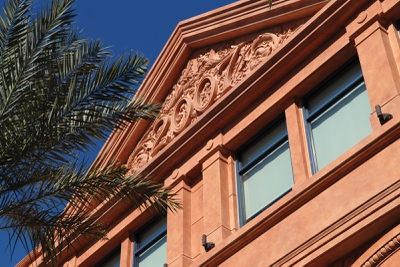
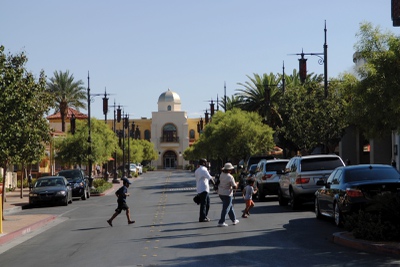
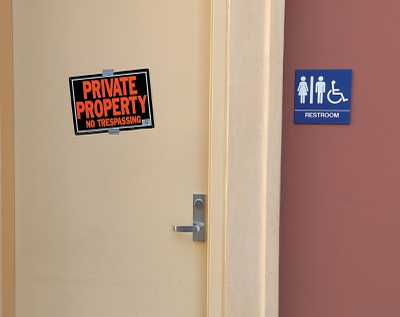
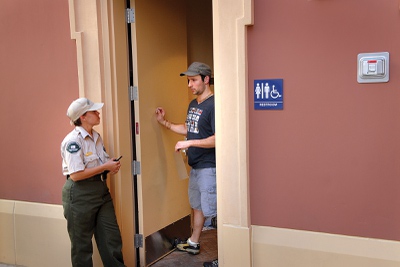
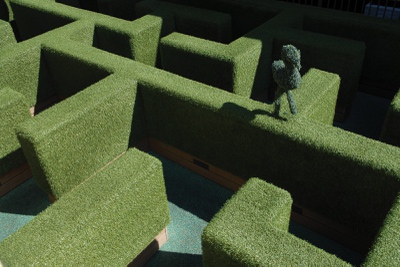

Join the Discussion:
Check this out for a full explanation of our conversion to the LiveFyre commenting system and instructions on how to sign up for an account.
Full comments policy